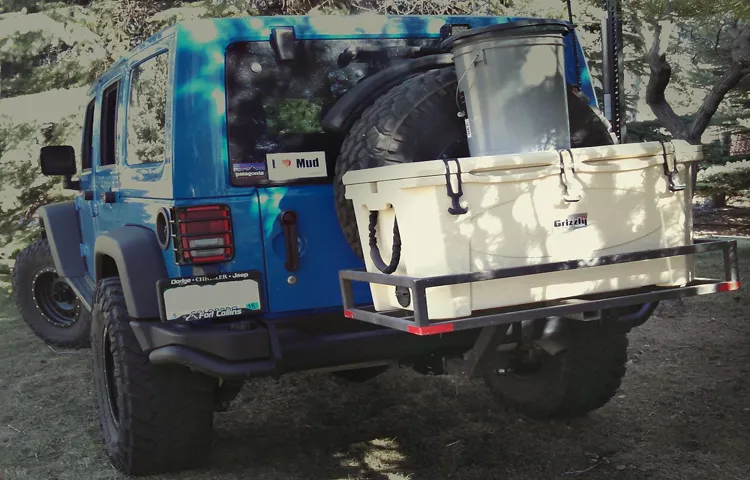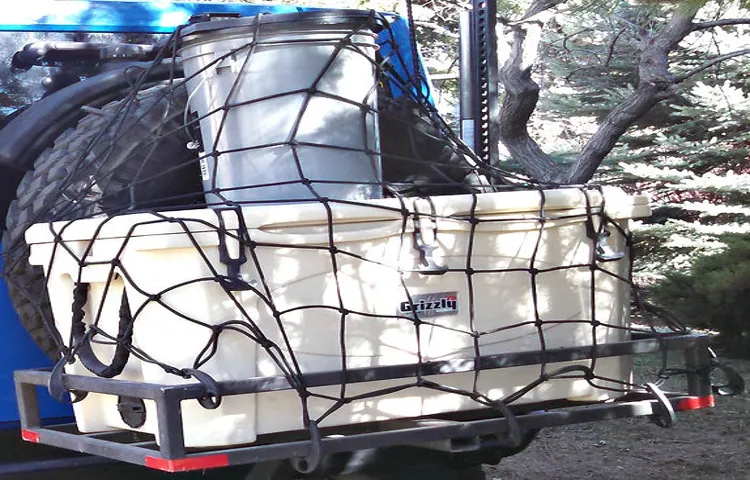Are you planning a road trip or outdoor adventure? One essential item you might need is a hitch cargo carrier to transport your gear and belongings. This convenient accessory attaches to the back of your vehicle, providing extra storage space for luggage, camping equipment, or sports gear. However, while a hitch cargo carrier is a practical solution for hauling your belongings, it’s important to secure it properly to ensure a safe and stress-free journey.
In this blog post, we will explore some tips and techniques for securing your hitch cargo carrier, so you can hit the road with confidence and peace of mind. So, let’s dive in and discover how you can keep your cargo carrier secure and your belongings intact during your next adventure.
Table of Contents
Choose a High-Quality Cargo Carrier
When it comes to securing a hitch cargo carrier, the first step is to choose a high-quality one. There are many options available on the market, so it’s important to do your research and find one that is sturdy and durable. A high-quality cargo carrier will be able to withstand the weight of your items and will be able to secure them properly.
Look for carriers that have a strong frame and secure attachment points. Additionally, consider the size and capacity of the carrier to ensure that it can accommodate your needs. By choosing a high-quality cargo carrier, you can have peace of mind knowing that your items will be safe and secure during transportation.
Research different brands and models to find a cargo carrier that is known for its durability and secure attachment mechanisms.
When it comes to choosing a cargo carrier, it’s important to do your research and find a high-quality option that will meet your needs. Look for brands and models that are known for their durability and secure attachment mechanisms. Don’t settle for a cheaply made carrier that could break or come loose while you’re on the road.
Instead, invest in a carrier that will last and provide peace of mind. Consider reading customer reviews and ratings to get an idea of how well a particular brand or model holds up over time. Remember, a cargo carrier is an investment in the safety of your belongings, so it’s worth taking the time to find one that is built to last.

Ensure Proper Installation of Hitch Receiver
Alright, so you’ve invested in a hitch cargo carrier to help you haul all your gear and make your outdoor adventures even better. But now you might be wondering, how do I secure this thing properly? Well, the first step is to ensure that your hitch receiver is installed correctly. The hitch receiver is the metal tube that extends out from the rear of your vehicle and allows you to attach the cargo carrier.
It’s important to make sure that the hitch receiver is securely attached to your vehicle, as this is what will bear the weight of your cargo carrier and its contents. To install the hitch receiver, first, you need to locate the mounting holes on your vehicle. These are typically found underneath your vehicle’s rear bumper.
Once you’ve located the mounting holes, you’ll need to carefully align the hitch receiver with the holes and insert the bolts through the mounting holes and hitch receiver. Tighten the bolts securely using a socket wrench, making sure that the hitch receiver is level and flush against your vehicle. Next, you’ll want to double-check that the hitch receiver is properly installed by giving it a gentle tug to ensure it’s securely attached.
If it feels loose or wobbly, you may need to adjust the positioning or tighten the bolts further. Once you’ve confirmed that the hitch receiver is securely installed, it’s time to attach your hitch cargo carrier. To do this, simply slide the shank of the cargo carrier into the hitch receiver, making sure that the pin holes on the shank align with the holes on the hitch receiver.
Once aligned, insert the hitch pin through the holes and secure it with a clip or lock. Give the cargo carrier a firm shake to make sure it’s securely attached. In addition to properly installing the hitch receiver, it’s also important to make sure that your hitch cargo carrier is loaded and secured correctly.
Be sure to distribute the weight evenly across the carrier and use tie-down straps or bungee cords to secure your cargo. Never exceed the weight limit specified by the manufacturer. So, by following these steps and ensuring the proper installation of your hitch receiver, you can have peace of mind knowing that your hitch cargo carrier is securely attached and ready to transport all your gear on your next adventure.
Make sure the hitch receiver is properly installed on your vehicle and securely tightened. This will provide a solid foundation for your cargo carrier.
When it comes to hauling heavy loads with your vehicle, it’s crucial to ensure that the hitch receiver is properly installed. A hitch receiver provides a solid foundation for your cargo carrier and allows you to safely transport your belongings. So, how do you ensure proper installation? First and foremost, make sure that the hitch receiver is compatible with your vehicle’s make and model.
This will ensure a secure fit and prevent any issues down the road. Once you have the right hitch receiver, it’s time to install it. Start by reading the installation instructions provided by the manufacturer.
They will give you step-by-step guidance on how to properly attach the hitch receiver to your vehicle. Ensure that all the necessary hardware is included and in good condition. This includes bolts, washers, and nuts.
As you begin the installation process, make sure to follow the instructions carefully and securely tighten all the bolts. This will ensure that the hitch receiver is firmly attached to your vehicle and can handle the weight of your cargo carrier. Remember, a proper installation is the key to a safe and successful hauling experience.
Use Hitch Pins or Locks
When it comes to securing your hitch cargo carrier, one of the essential steps is to use hitch pins or locks. These handy devices help keep your cargo carrier firmly attached to your vehicle’s hitch receiver, giving you peace of mind while you travel. Hitch pins are simple metal pins that go through the holes in the hitch receiver and the cargo carrier, securing them together.
They are easy to insert and remove and are available in various sizes to fit different hitch sizes. On the other hand, hitch locks provide an extra layer of security by preventing the hitch pins from being removed without a key. This is especially useful if you plan on leaving your vehicle unattended or parking in public areas.
By using hitch pins or locks, you can ensure that your hitch cargo carrier stays securely in place, regardless of the road conditions or speed. So the next time you hit the road with your cargo carrier, don’t forget to secure it with hitch pins or locks for a worry-free journey.
Use hitch pins or locks to secure the cargo carrier to the hitch receiver. These devices prevent the carrier from accidentally detaching during travel.
Hitch pins or locks may seem like a small detail when it comes to securing your cargo carrier, but they play a crucial role in ensuring that your gear arrives safely at your destination. These simple devices are designed to prevent the carrier from accidentally detaching from the hitch receiver while you’re on the road. Just imagine the chaos that could occur if your cargo carrier were to come loose and spill its contents all over the highway! With a hitch pin or lock in place, you can rest easy knowing that your gear will stay securely in place no matter how bumpy the road gets.
So don’t forget to invest in these small but mighty accessories before hitting the road with your cargo carrier.
Tighten Mounting Bolts
If you’re planning a road trip or just need some extra storage space for your belongings, a hitch cargo carrier is a great option. However, it’s important to make sure that your cargo carrier is securely attached to your vehicle to avoid any mishaps or accidents on the road. One simple and effective way to secure your hitch cargo carrier is to tighten the mounting bolts.
These bolts are what hold the cargo carrier in place, so it’s crucial to make sure they are tight and secure. Using a wrench or socket set, tighten the mounting bolts as much as possible to ensure a sturdy and stable attachment. Check them periodically to make sure they haven’t loosened during your trip.
By taking this simple step, you can have peace of mind knowing that your hitch cargo carrier is securely fastened to your vehicle and your belongings will arrive safely at your destination.
Make sure all mounting bolts are securely tightened to prevent any movement or rattling of the cargo carrier while driving.
In order to ensure a smooth and hassle-free journey with your cargo carrier, it is crucial to tighten all the mounting bolts securely before hitting the road. This step will prevent any unwanted movement or rattling of the carrier while you’re driving. Imagine the inconvenience of hearing constant rattling noises coming from the back of your car – it can be distracting and downright annoying! So, taking the time to tighten those bolts properly will save you from such headaches.
Just like securing the pieces of a puzzle, tightening the mounting bolts ensures that the cargo carrier stays in place, giving you peace of mind as you embark on your adventure. So, before you head out, go over each bolt and tighten them snugly to keep your cargo carrier securely in place throughout your journey.
Secure the Cargo
When it comes to traveling with a hitch cargo carrier, it’s important to ensure that your cargo is properly secured. The last thing you want is for your belongings to go flying off the carrier and onto the road. So, how can you make sure that everything stays in place? First, start by using high-quality tie-down straps or cargo nets to secure the items to the carrier.
Make sure to tighten them securely so that there is no chance of them coming loose. Additionally, consider using bungee cords or cargo bars to further secure the items in place. These additional measures can provide an extra layer of protection and help prevent any shifting or movement during transit.
It’s also a good idea to distribute the weight evenly across the carrier to maintain balance and stability. Remember, safety should be your top priority when it comes to transporting your cargo, so taking the time to properly secure it will give you peace of mind on the road.
Use tie-down straps or cargo nets to secure your items to the cargo carrier. This will prevent them from shifting or falling off during transit.
When it comes to transporting your items on a cargo carrier, it’s important to secure them properly to prevent any mishaps on the road. One of the best ways to do this is by using tie-down straps or cargo nets. These handy tools help keep your items in place, ensuring they don’t shift or fall off during transit.
Just think of them as seatbelts for your cargo! By tightly securing your items to the cargo carrier, you can have peace of mind knowing that they will stay put throughout your journey. Whether you’re moving furniture, camping gear, or even bikes, using tie-down straps or cargo nets is a must for safe and secure transportation. So before you hit the road, make sure to properly secure your cargo using these essential tools!
Regularly Inspect and Maintain
When it comes to securing your hitch cargo carrier, one of the most important things you can do is regularly inspect and maintain it. Over time, the straps and attachments can become worn or damaged, which can compromise the security of your cargo carrier. By checking for any signs of wear or damage before each use, you can ensure that your cargo carrier is in proper working order.
This includes inspecting the straps, buckles, and any other attachments to make sure they are secure and in good condition. Additionally, it’s important to regularly clean your cargo carrier to prevent any buildup of dirt or debris that could interfere with its function. Taking the time to inspect and maintain your hitch cargo carrier on a regular basis will not only help ensure the security of your cargo, but also prolong the lifespan of your carrier.
So, make it a habit to give it a quick once-over before each use and you’ll have peace of mind knowing that your cargo is secure on the road.
Regularly inspect all components of your hitch cargo carrier, including the hitch receiver, mounting bolts, and tie-down straps. Make any necessary repairs or replacements to ensure continued security during travel.
Regularly inspecting and maintaining your hitch cargo carrier is crucial to ensure the security of your belongings during travel. Start by inspecting the hitch receiver to make sure it is free from any dirt, rust, or damage that could affect its stability. Check the mounting bolts as well, tightening them if necessary to prevent any loosening during transit.
Additionally, examine the tie-down straps to ensure they are in good condition with no fraying or tears. If you notice any issues or wear and tear, make the necessary repairs or replacements before hitting the road. By being proactive in your maintenance routine, you can have peace of mind knowing that your hitch cargo carrier is in optimal working condition and will securely transport your items to your desired destination.
Conclusion
So there you have it, all the essential tips and tricks for securing your hitch cargo carrier like a pro. Remember, the key to a successful hauling adventure is staying vigilant and prepared. By following these steps, you’ll be able to protect your valuable belongings from the unpredictable roads and ensure a smooth and secure journey.
Just like a master planner, you’ll have everything securely fastened and neatly organized, leaving no room for mishaps or loose ends. So go forth, hitch up that cargo carrier, and let the adventure begin – with the confidence of a seasoned traveler!”
By following these steps, you can ensure that your hitch cargo carrier is securely attached to your vehicle and your items are safely transported from one place to another.
Regularly inspecting and maintaining your hitch cargo carrier is crucial in ensuring the safety and security of your items during transportation. By following these steps, you can rest assured that your cargo carrier is securely attached to your vehicle. Firstly, always check for any signs of rust or wear and tear on the hitch and carrier.
This can weaken the structure and compromise its effectiveness. Secondly, inspect the cargo carrier’s straps and fasteners for any signs of fraying or damage. Replace any worn or damaged parts promptly to avoid any potential accidents.
Additionally, be sure to clean the carrier after each use to prevent the buildup of dirt and debris. Lastly, test the carrier’s stability by giving it a gentle shake before hitting the road. If there are any excessive movements or wobbling, re-tighten the straps or adjust the attachment points accordingly.
Remember, regularly inspecting and maintaining your hitch cargo carrier will not only keep your items safe but also provide peace of mind during your travels.
FAQs
How do I secure a hitch cargo carrier to my vehicle?
To secure a hitch cargo carrier to your vehicle, first, ensure that your hitch receiver is the correct size and class for your carrier. Then, line up the carrier with the hitch receiver and insert the hitch pin or bolt to secure it in place. Finally, secure the carrier further with any additional straps or locks included with the carrier.
What is the maximum weight capacity for a hitch cargo carrier?
The maximum weight capacity for a hitch cargo carrier can vary depending on the specific model. It is important to check the product specifications to determine the weight capacity of your particular carrier. Exceeding the weight limit can lead to damage to your vehicle or the carrier itself.
Can I use a hitch cargo carrier on a car without a trailer hitch?
No, a hitch cargo carrier requires a trailer hitch receiver to attach to your vehicle. If your car does not have a trailer hitch, there are other types of cargo carriers available, such as roof-mounted or trunk-mounted carriers, which may be more suitable for your vehicle.
Are hitch cargo carriers compatible with all vehicles?
Hitch cargo carriers are compatible with most vehicles that have a trailer hitch receiver. However, it is important to verify the weight capacity of your hitch receiver and ensure that it is the correct size and class for the carrier you plan to use. Additionally, some vehicles may have limitations on the use of hitch cargo carriers due to factors such as ground clearance or rear visibility.
Can I use a hitch cargo carrier for transporting bicycles?
Yes, many hitch cargo carriers are designed to be compatible with bike racks. These carriers typically have a built-in or attachable bike rack feature that allows you to securely transport bicycles alongside your other cargo. It is important to check the product specifications and weight capacity to ensure that it can accommodate the weight and number of bicycles you plan to transport.
How do I prevent theft of a hitch cargo carrier?
To prevent theft of a hitch cargo carrier, you can use a hitch lock or a cable lock. A hitch lock attaches to the hitch pin or bolt, preventing it from being removed. A cable lock can be used to secure the carrier and its contents to a fixed object, such as a tree or post. Additionally, parking your vehicle in a well-lit and secure area can also deter theft.
Can I use a hitch cargo carrier in winter conditions?
Yes, hitch cargo carriers are typically designed to withstand various weather conditions, including winter. However, it is important to consider the weight of the cargo and the impact it may have on your vehicle’s performance, especially in icy or snowy conditions. Additionally, it is recommended to regularly clean and maintain the carrier to prevent damage from road salts or debris.



